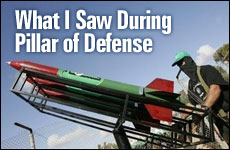 We Were the Lucky Ones
We Were the Lucky Ones


4 min read
3 min read
7 min read
5 min read
I worked 20 hours a day as a soldier in the IDF, providing goods and services to civilians in Gaza.
Four years ago, watching the coverage of Operation Cast Lead from the comfort of my dorm, I was a conflicted college student. As supportive as I was of Israel, I still found it painful any time I heard about civilian casualties in Gaza. What I saw portrayed in the media didn't add up: On one hand I knew that the IDF was engaged in careful efforts to prevent civilian casualties, despite Hamas's strategy of fighting from amongst its own civilian population. Yet the media made it seem like the IDF was actively targeting civilians.
Back then, I understood Israel's efforts at protecting civilians as a something akin to a talking point – I had no personal involvement in the conflict. Yet I had no idea how true it is until I myself participated in last week's Operation "Pillar of Defense" as an officer in the IDF.
In 2010 when I moved from Arizona to Israel to Israel and enlisted, I joined a unit called the Coordinator of Government Activities in the Territories (COGAT), which is devoted to civilian and humanitarian issues.
As an International Liaison Officer in the Gaza office, my job primarily entails coordinating transfers of goods, aid, and delegations into Gaza. I work closely with representatives of the international community, and although our perspectives may differ, we maintain relationships of mutual respect born of a common goal; I am here to help them succeed in their work improving the quality of life in Gaza.
While the day-to-day work is challenging in Gaza, I learned over the past 10 days that the true test comes with crisis. At exactly the point where most militaries would use the heat of war to throw out the rulebook, we worked harder than ever to provide assistance wherever and whenever possible.
Sense of Purpose
The eight days of Operation "Pillar of Defense" were some of the hardest I have ever known physically and emotionally. The college student from Arizona would never have thought it possible to work 20 hours a day, fueled only by adrenaline and longing for just an hour of sleep on a shelter floor, wearing the same filthy uniform – because changing, much less showering, wouldn't enable me to get to a shelter in time when the next rocket barrage hit. And no, wearing the green uniform does not mean that you aren't afraid when the sirens sound.
Had you told me four years ago that there were IDF officers who stayed up all night under a hail of rockets, brainstorming ways to import medical supplies and food to the people of Gaza, I am not sure I would have believed you. But I can tell you it is true because I did it every night.
What amazed me the most was the singular sense of purpose that drove everyone, from the base commander to the lowest ranking soldier. We were all completely focused on our mission: to help our forces accomplish their goals without causing unnecessary harm to civilian lives or infrastructure.
It is harder to explain the emotional roller-coaster – how proud and relieved I felt every time a truck I coordinated entered Gaza, and how enraged I was when we had to shut down the crossing into Gaza after Hamas repeatedly targeted it. Or how invigorating it was help evacuate two injured Palestinians from the border area, only to be informed minutes later that a terrorist had detonated a bomb on a bus near my apartment in Tel Aviv.
Behind the Headlines.
After all that I see and do, nothing frustrates me more than the numbers game that is played in the media. The world talks about "disproportionate" numbers of casualties as the measure of what is right and wrong – as if not enough Israelis were killed by Hamas for the IDF to have the right to protect its own civilians from endless rocket attacks.
Hamas hides behind human shields, to win a cynical media war.
In my position, I see the surgical air strikes, and spend many hours with the UN, ICRC, and NGO officers reviewing maps to help identify, and avoid, striking civilian sites. One of our pilots who saw a rocket aimed at Israel aborted his mission when he saw children nearby – putting his own civilians at risk to save Gazans. At the end of the day, what these "disproportionate numbers" show is how we in Israel protect our children with elaborate shelters and missile defense systems, whereas the terror groups in Gaza hide behind theirs, using them as human shields in order to win a cynical media war.
What's really behind the headlines and that picture on the front page? Every day, I coordinate goods with a young Gazan woman who works for an international aid organization. Last month we forged a bond when we had to run for cover together when Hamas targeted Kerem Shalom Crossing – attacking the very aid provided to its own people.
During the eight days of Operation "Pillar of Defense," not one passed without a phone call, just to check in. "Are you okay?" I would ask.
"I heard they fired at your base. Please stay safe," she would reply. And every night I made her promise to call me if she needed anything.
These are the things that the media fails to show the world, just as they underplay how Hamas deliberately endangers civilians on both sides of the border – by firing indiscriminately at Israel from Gaza neighborhoods.
Maybe stories such as these make for less exciting headlines, but if they received more attention, we would all have more moral clarity, and a greater chance for peace in the Middle East.
This article originally appeared on americanthinker.com
